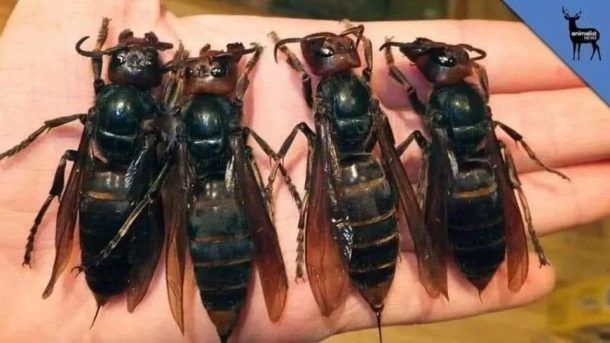Ever heard the saying, “It was so big, it almost scared me to death!”? Though there are giant bugs in nature, often the size can be deceiving. Large bugs have a tendency to look scary or like something creepy from another world, which often instills fear and anxiety. However, the deadliest insects are not necessarily the largest or the scariest looking. There are many insects in our world that deserve to be feared and avoided if at all possible, despite their size and appearance!
With Ehrlich Pest Control, there is no need to fear. Our expert pest specialists have the experience and know-how to keep you and your family safe. Give us a call at 888-984-0186 with any pest problem, big or small.
Top 10 deadliest insects
10. Locusts
Surprised? While they do not directly kill humans, the devastation that an invasion can cause has been responsible for crop devastation and the consequential starvation of millions in history from the biblical times to 1874 in the American Great Plains, and more recently, infestations in Niger. The locusts will always eat, but you might NOT.
9. Bot Flies
Could there be anything more disgusting than flies developing under your skin and then eating their way out? If you are vacationing south of the U.S. border, in Mexico or down through South America and the rainforests, take precautions and beware of subtle illness after returning home. It has been reported that a person can hear these parasites when the infestation is around the neck area.
8. Giant Japanese Hornets
These guys are not to be taken lightly. Measuring 2 to 3 inches, this hornet carries a toxin that often leads to paralysis, kidney failure, and death, oftentimes a slow one, in those that are bitten. Much like mosquitoes, this Asian pest is attracted to humans who sweat, drink alcohol, smell sweet, or are running. So when vacationing in Asia, consider this hornet when you are deciding on activities.
7. Bees
How can these cute little fuzzy, pollen-collecting and honey-making insects be a danger? Bees are very territorial and will protect their queen with their life. With the introduction of the Africanized bee, this trait has been cross-bred into the American honey bee making them more aggressive and unpredictable. When an attack is imminent, it comes with an army of angry bees that give signals to all that the danger must be eliminated. When handling beehives, it is best to enlist the help of a professional. They can help you remove and relocate the hive to a more safe location.
6. Mosquitoes
How can such a small pest be so dangerous? Despite their size, they carry life-threatening diseases, and measures should be taken to protect against large infestations. This tiny pest is responsible for much misery and death. Nowhere in the United States is safe from mosquitoes; they are found everywhere, even in Alaska! There are areas in the U.S. that are prime real estate for mosquitoes…but the truth is warm/hot weather and any puddle of stagnant water is a breeding ground. Make sure that your yard is not welcoming them in. Change pet water bowls daily, repair leaking hoses, change bird bath water frequently, and eliminate any other sources of standing water. There are mosquitoes that can and do breed inside something as simple as a discarded damp potato chip bag!
5. Fleas
A flea’s life is spent searching for a place to call home, where they can enjoy a meal of sweet warm blood. These little parasites can be found on reptiles, mammals, domestic animals, and humans! Over the centuries this little pest has caused devastation over the centuries. The Black Plague and Typhus are a couple of flea-borne diseases that have been devastating to communities.
4. Kissing bugs
The kissing bug, how sweet, a bug that gives kisses. However, the name is deceiving. It is actually a blood-sucking parasite that is attracted to its feeding sites by breath. So if you breathe through your mouth, you are a target. This kisser leaves behind a gift after he is done feasting…Chagas; which can be a life-threatening illness.
3. Fire Ants
These little ants build their colonies on the ground in soil and sand, very close to your feet! If you’re not careful, your feet can be covered in record time and the biting begins before you ever have a chance to get away. Fire ants are very protective of their colonies and so intruders are given NO mercy. Not only are these bites painful but they can cause very severe reactions, especially in those with fire ant allergies.
2. Bullet Ants
These ants are 1 to 2 inches in length and their name is an indication of what a bite may feel like – being shot! At a minimum, the pain is extreme, sometimes leading to paralysis. Justin O. Schmidt, an entomologist who famously created the Schmidt Pain Index for insect stings, described the bullet ant bite like, “walking over flaming charcoal with a three-inch rusty nail in your heel.” These pests are NOT to be messed with.
1. Driver Ants
No, they do not drive your car! They get their name because they are continually on the move, looking for food. Their numbers are so enormous that they need a new food source every few days. Most of the deaths associated with these ants are the researchers on location. They are indigenous to the Congo where the native Africans have learned to use these travelers to their advantage. When they are marching towards their community, they will move, to return as these ants move on. What they have upon return is spring cleaning, the floods of pests that plague their lives are gone if only temporarily. These ants’ mandibles are so strong, the natives also use them as sutures, encouraging the bite in the sides of the cut, and then breaking off the body, leaving only the head behind. The victims of these ants are usually tethered animals, caged chickens and infants that can not escape the massive invasion.



